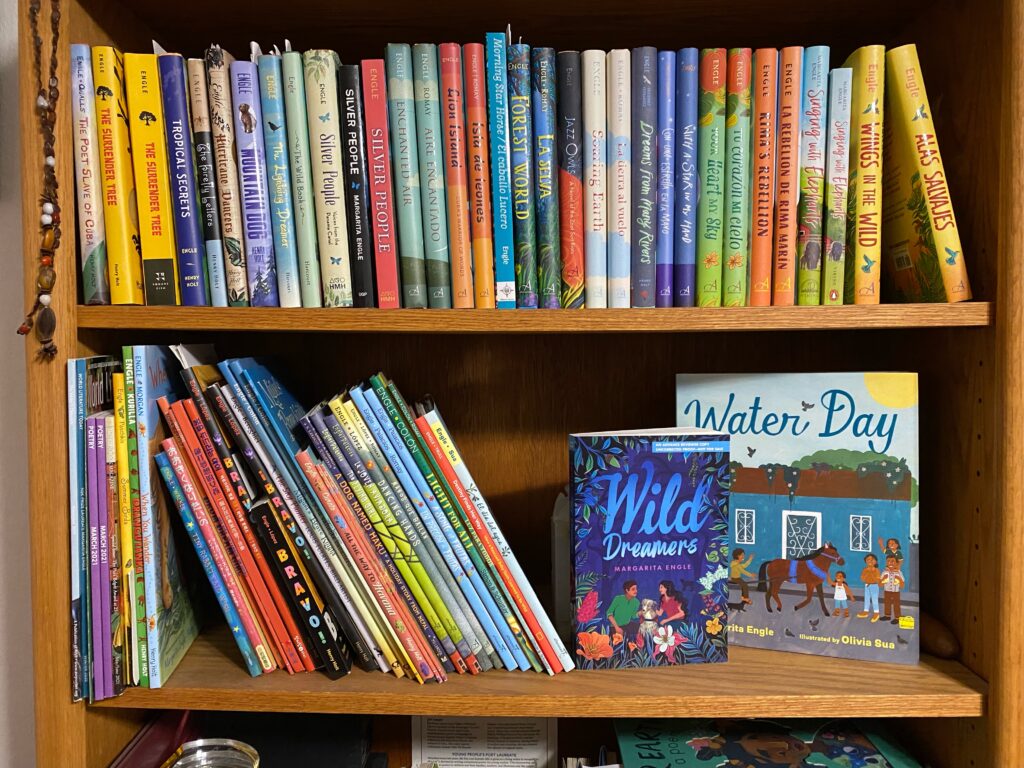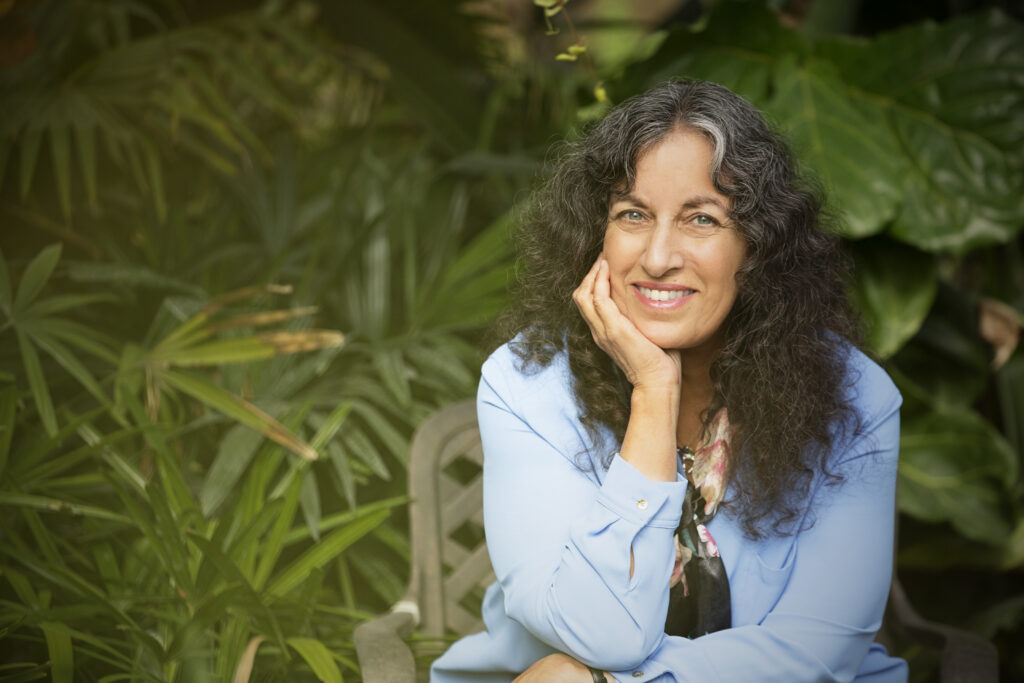Wild Dreamers, a guest post by Margarita Engle

Wild Dreamers is a young adult verse novel about environmental activists who fall in love while struggling to find hope in difficult situations. Wild Dreamers is loosely linked to two of my other recent “ecoromance” verse novels, Wings in the Wild, and Your Heart, My Sky. All three of these books have beautiful, botanically rich Gabi D’Alessandro cover art, and all three combine love stories with environmental action by Cuban and Cuban American teenagers. These are essentially STEM books that can be used to teach biology, but there is also a touch of magic that emerges from Cuba’s Indigenous Taíno culture.
In Wild Dreamers, Ana and Leandro start a rewilding club at their high school, and train a conservation dog to help scientists study urban mountain lions that live in genetic islands separated by traffic. Wildlife crossings over highways are needed to help the pumas mate without inbreeding that causes mutations. Conservation dogs are trained to help locate the pumas, so communities can determine where the wildlife crossings should be constructed. Along the way, the teens fall in love and face other challenges. Even though this story is fiction, all the puma incidents are real, including strolls through beach towns in daytime, and the abandonment of cubs by starving mothers.
ADVERTISEMENT
ADVERTISEMENT

The story is told in alternating voices, including that of Cielo, the singing dog. I find that first person and present tense are the best way to invite readers to feel each character’s emotions. In fact, “How does the poem make you feel?” is the question I hope teachers will ask students, instead of, “What does the poem mean?” That’s partly because a poem can have different meanings for different readers, and also because poetry is musical language. Just like music, poetry is meant to be enjoyed, not dissected.
Verse novels are interactive. The open spaces between lines, stanzas, and poems are not empty. They are filled with a resonance that can be compared to the vibrations after ringing a bell. These open spaces are an invitation to pause, ask questions, experience a sense of wonder, and perhaps even write one’s own poems in response to the author. In other words, I think of poetry’s open spaces as a sky where the emotions of a poet and reader rise up and meet in midair.
I write about young people, plants, animals, and Cuban culture because of my own childhood. During visits to my mother’s extended family on the island, I fell in love with tropical nature, while absorbing the desperation of my bisabuela, abuela, tíos, y primos as they experienced the turmoil that followed the revolution. By the time I was a teenager, travel restrictions were so severe that it was easier for a U.S. citizen to travel to the moon than to visit relatives in Cuba.
In college I studied agronomy and botany. I taught at an agricultural university, and worked for an irrigation water conservation project. I wrote technical articles, but never gave up my passion for poetry, and my dedication to a peaceful solution to the hostility between the two countries I love. Eventually I became a full time author of verse novels and picture books for young people. Normal diplomatic relations and normal travel between Cuba and the U.S. is still a dream, but I visit whenever I can, despite the restrictions.
Verse novels are now my refuge. When I’m writing poetry, I feel hopeful. Free verse, rhythms, vowel rhymes, and internal rhymes all contribute to a way of expressing emotion that helps me feel like my words can fly. I hope they soar toward readers who seek hope. Poetry is a safe space for the confusion, sorrow, and rage of all our lives, but this is especially true of adolescence. Teenagers often read and write poetry. Some might keep it secret, but when they write, they have a way to express themselves. When we listen to each other’s poems and stories, our minds grow wings. We visit each other’s worlds. We begin to understand each other. We become neighbors instead of strangers.
If Wild Dreamers and my other verse novels have a legacy, I hope it will be one that honors peacemakers.
Meet the author

Margarita Engle is the Cuban-American author of books such as Enchanted Air, Drum Dream Girl, Dancing Hands, and The Surrender Tree, which received a Newbery Honor. She served as the national 2017-2019 Young People’s Poet Laureate. Other awards include Pura Belpré Medals, the Golden Kite Award, Walter Honors, Américas Awards, Jane Addams Award, PEN U.S.A., and NSK Neustadt Prize. Recent young adult verse novels include Wings in the Wild and Wild Dreamers. Recent picture books include Water Day and The Sculptors of Light. Engle’s next verse novel is Island Creatures, and her next picture book is Eloísa’s Musical Window.
ADVERTISEMENT
ADVERTISEMENT
Margarita was born in Los Angeles, but developed a deep attachment to her mother’s homeland during childhood summers with relatives on the island. She studied agronomy and botany along with creative writing, and now lives in central California with her entomologist husband and squirrel-chasing Border Collie.
Facebook: Margarita Engle
Twitter: @margaritapoet
Instagram: @engle.margarita
About Wild Dreamers
In this stirring young adult romance from award-winning author Margarita Engle, love and conservation intertwine as two teens fight to protect wildlife and heal from their troubled pasts.
Ana and her mother have been living out of their car ever since her militant father became one of the FBI’s most wanted. Leandro has struggled with debilitating anxiety since his family fled Cuba on a perilous raft.
One moonlit night, in a wilderness park in California, Ana and Leandro meet. Their connection is instant—a shared radiance that feels both scientific and magical. Then they discover they are not alone: a huge mountain lion stalks through the trees, one of many wild animals whose habitat has been threatened by humans.
Determined to make a difference, Ana and Leandro start a rewilding club at their school, working with scientists to build wildlife crossings that can help mountain lions find one another. If pumas can find their way to a better tomorrow, surely Ana and Leandro can too.
ISBN-13: 9781665939751
Publisher: Atheneum Books for Young Readers
Publication date: 04/23/2024
Age Range: 12 – 18 Years
Filed under: Guest Post
About Amanda MacGregor
Amanda MacGregor works in an elementary library, loves dogs, and can be found on BlueSky at @amandamacgregor.bsky.social.
ADVERTISEMENT
ADVERTISEMENT
SLJ Blog Network
Notes on April 2025
A Brand New Substack (and Some Thoughts on Picture Books Without Plot Or Conflict)
The Last Witch: Blood & Betrayal | Exclusive Preview
30 Contenders? Our Updated Mock Newbery List
When Book Bans are a Form of Discrimination, What is the Path to Justice?
ADVERTISEMENT







